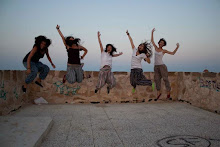From staying in Guardamar del Segura for around 3 weeks, I
have walked the same streets many times to get to those same locations: the pension,
studio, café movellán, mercadona, the beach, the parks, and the dunes sites.
These streets are all part of the greater urban landscape that is Guardamar.
From this class and from walking on these streets at different times of the
day, I have begun to realize how much importance people have to decorating
these urban spaces and changing the function of these spaces.
Living so close to the beach, it is not a surprise that I
have made many trips to the beach and the adjacent boardwalk area. I remember
going in the morning in the very beginning of our time at Guardamar and seeing
some people enjoying the gentler
morning sun and catching some waves. It was a very tranquil space with the
background noise of people enjoying their tostadas and cafes con leche. We
would also go to a set of chairs and tables on a specific part of the beach at
night a lot. At this time, the beach would be very quiet, and I would only hear
the sounds of the waves crashing down on the sand and the wind blowing in the
night along with the sounds of my friends’ laughter. However, towards the end
of June a yearly festival, Las Hogueras
de San Juan, occurs and it is ritual to build a giant bonfire on the beach
and people from all around come to Guardamar to enjoy the spectacle and take
part in the ritualistic activities. Suddenly, this strip on the beach that I
have walked on so many times during the day and night is transformed: instead
of small groups of people spread out here and there enjoying the sun and sea
the space becomes a sea of people crowded around a pile of wood shouting and
cheering. With this ritual and the dramatic increase of people, this urban
space is completely different in terms of usage and sound.
Similarly, the
public space around the church is a very calm space during the day (except for
on Wednesdays when the Mercadillo comes to invade from 6 am to 2pm). But with
the tradition of La Cremá, where a
giant sculpture is designed, built, and then lit up in flames and burned in
close proximity to all the important buildings, this space is also completely
changed for those short hours when the sculpture is burned down.
 The most recent
ritual is the one that happens at the end of July – Festival de Moros y Cristianos. This weeklong festival has
definitely changed the landscape: festive street lights are hung all along the
main roads; roads are blocked off when parades pass by and firecrackers go off,
so people walk on the roads instead of cars; chairs line the roads in
anticipation of whatever magnificent, exploding fire festivity is planned for
that night. More people walk around and public spaces are more full and used
later in the night.
The most recent
ritual is the one that happens at the end of July – Festival de Moros y Cristianos. This weeklong festival has
definitely changed the landscape: festive street lights are hung all along the
main roads; roads are blocked off when parades pass by and firecrackers go off,
so people walk on the roads instead of cars; chairs line the roads in
anticipation of whatever magnificent, exploding fire festivity is planned for
that night. More people walk around and public spaces are more full and used
later in the night.
Reflecting on
past cities we’ve visited as a group, I realize that rituals and similar large
spectacles have the power to draw people to a city, and then the people change
these urban spaces and make them unique. Some examples include when we visited
Alicante and that week they had their Mascletas,
which is a daily spectacle of firecrackers that come together to form a
thunderous auditory and visual show. In the morning we passed by the street
where the mascleta would take place
and it looked like a normal road; at around 1:15 we returned to that street and
it was suddenly gated off with people surrounding the edges. Nearer to 2pm the
excitement was palpable and it was near impossible to move anywhere without
bumping into someone else. After the mascleta,
the street cleared up almost immediately and people began moving away. At the
very beginning, we arrived on the day of the football champions final hosted by
Madrid. All the plazas we visited became venues to watch the game and to party
with giant platforms and tents for sponsors set up. Before leaving Madrid, we
witnessed these spaces transform as the champions game ended and the urban
spaces returned to what they were before this big event. Instead of crowded
areas where people came to dance and drink, the plazas were transition spaces
that people would pass by and occasionally stop to meet with people –
completely different to how people were using the space just 24 hours prior.
Even small,
everyday ‘rituals’ such as the siesta
that occurs around 2-6pm when it gets too hot outside to do anything changes
the urban landscape. During mornings and nights the streets have people on them
as they walk around or eat outside under umbrellas. During siesta time, the
streets are empty and there will be the lone car that passes by.
Now more than
ever I understand how you cannot talk about urban spaces and architecture
without also talking about people. I also definitely think more about how I am
participating with and changing the urban space instead of just occupying the
space.
-- Adeline :)

No comments:
Post a Comment